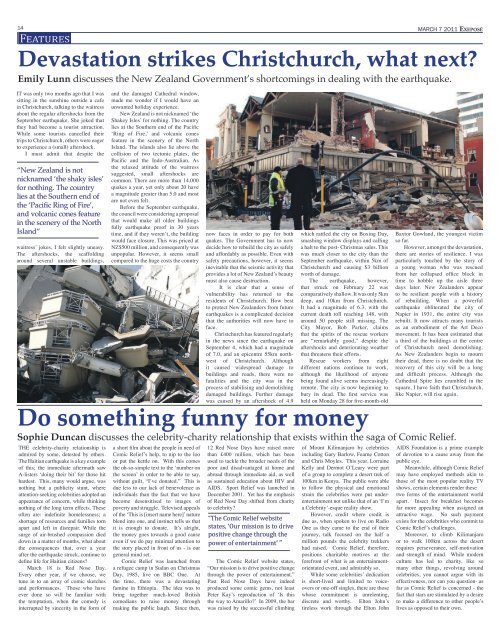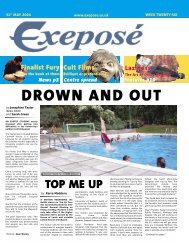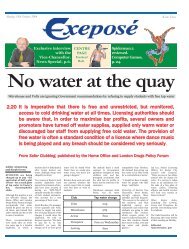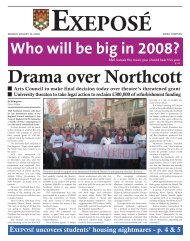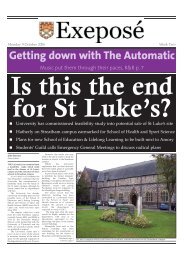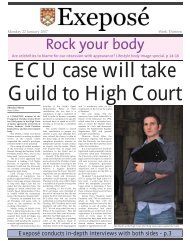Exeter student - Exeposé - University of Exeter
Exeter student - Exeposé - University of Exeter
Exeter student - Exeposé - University of Exeter
Create successful ePaper yourself
Turn your PDF publications into a flip-book with our unique Google optimized e-Paper software.
14<br />
Features<br />
march 7 2011 Exeposé<br />
Devastation strikes Christchurch, what next<br />
Emily Lunn discusses the New Zealand Government’s shortcomings in dealing with the earthquake.<br />
IT was only two months ago that I was<br />
sitting in the sunshine outside a cafe<br />
in Christchurch, talking to the waitress<br />
about the regular aftershocks from the<br />
September earthquake. She joked that<br />
they had become a tourist attraction.<br />
While some tourists cancelled their<br />
trips to Christchurch, others were eager<br />
to experience a (small) aftershock.<br />
I must admit that despite the<br />
“New Zealand is not<br />
nicknamed ‘the shaky isles’<br />
for nothing. The country<br />
lies at the Southern end <strong>of</strong><br />
the ‘Pacific Ring <strong>of</strong> Fire’,<br />
and volcanic cones feature<br />
in the scenery <strong>of</strong> the North<br />
Island”<br />
waitress’ jokes, I felt slightly uneasy.<br />
The aftershocks, the scaffolding<br />
around several unstable buildings,<br />
and the damaged Cathedral window,<br />
made me wonder if I would have an<br />
unwanted holiday experience.<br />
New Zealand is not nicknamed ‘the<br />
Shakey Isles’ for nothing. The country<br />
lies at the Southern end <strong>of</strong> the Pacific<br />
‘Ring <strong>of</strong> Fire,’ and volcanic cones<br />
feature in the scenery <strong>of</strong> the North<br />
Island. The islands also lie above the<br />
collision <strong>of</strong> two tectonic plates, the<br />
Pacific and the Indo-Australian. As<br />
the relaxed attitude <strong>of</strong> the waitress<br />
suggested, small aftershocks are<br />
common. There are more than 14,000<br />
quakes a year, yet only about 20 have<br />
a magnitude greater than 5.0 and most<br />
are not even felt.<br />
Before the September earthquake,<br />
the council were considering a proposal<br />
that would make all older buildings<br />
fully earthquake pro<strong>of</strong> in 30 years<br />
time, and if they weren’t, the building<br />
would face closure. This was priced at<br />
NZ$500 million, and consequently was<br />
unpopular. However, it seems small<br />
compared to the huge costs the country<br />
now faces in order to pay for both<br />
quakes. The Government has to now<br />
decide how to rebuild the city as safely<br />
and affordably as possible. Even with<br />
safety precautions, however, it seems<br />
inevitable that the seismic activity that<br />
provides a lot <strong>of</strong> New Zealand’s beauty<br />
must also cause destruction.<br />
It is clear that a sense <strong>of</strong><br />
vulnerability has returned to the<br />
residents <strong>of</strong> Christchurch. How best<br />
to protect New Zealanders from future<br />
earthquakes is a complicated decision<br />
that the authorities will now have to<br />
face.<br />
Christchurch has featured regularly<br />
in the news since the earthquake on<br />
September 4, which had a magnitude<br />
<strong>of</strong> 7.0, and an epicentre 55km northwest<br />
<strong>of</strong> Christchurch. Although<br />
it caused widespread damage to<br />
buildings and roads, there were no<br />
fatalities and the city was in the<br />
process <strong>of</strong> stabilising and demolishing<br />
damaged buildings. Further damage<br />
was caused by an aftershock <strong>of</strong> 4.9<br />
Do something funny for money<br />
Sophie Duncan discusses the celebrity-charity relationship that exists within the saga <strong>of</strong> Comic Relief.<br />
which rattled the city on Boxing Day,<br />
smashing window displays and calling<br />
a halt to the post- Christmas sales. This<br />
was much closer to the city than the<br />
September earthquake, within 5km <strong>of</strong><br />
Christchurch and causing $3 billion<br />
worth <strong>of</strong> damage.<br />
The earthquake, however,<br />
that struck on February 22 was<br />
comparatively shallow. It was only 5km<br />
deep, and 10km from Christchurch.<br />
It had a magnitude <strong>of</strong> 6.3, with the<br />
current death toll reaching 148, with<br />
around 50 people still missing. The<br />
City Mayor, Bob Parker, claims<br />
that the spirits <strong>of</strong> the rescue workers<br />
are “remarkably good,” despite the<br />
aftershocks and deteriorating weather<br />
that threatens their efforts.<br />
Rescue workers from eight<br />
different nations continue to work,<br />
although the likelihood <strong>of</strong> anyone<br />
being found alive seems increasingly<br />
remote. The city is now beginning to<br />
bury its dead. The first service was<br />
held on Monday 28 for five-month-old<br />
Baxtor Gowland, the youngest victim<br />
so far.<br />
However, amongst the devastation,<br />
there are stories <strong>of</strong> resilience. I was<br />
particularly touched by the story <strong>of</strong><br />
a young woman who was rescued<br />
from her collapsed <strong>of</strong>fice block in<br />
time to hobble up the aisle three<br />
days later. New Zealanders appear<br />
to be resilient people with a history<br />
<strong>of</strong> rebuilding. When a powerful<br />
earthquake obliterated the city <strong>of</strong><br />
Napier in 1931, the entire city was<br />
rebuilt. It now attracts many tourists<br />
as an embodiment <strong>of</strong> the Art Deco<br />
movement. It has been estimated that<br />
a third <strong>of</strong> the buildings at the centre<br />
<strong>of</strong> Christchurch need demolishing.<br />
As New Zealanders begin to mourn<br />
their dead, there is no doubt that the<br />
recovery <strong>of</strong> this city will be a long<br />
and difficult process. Although the<br />
Cathedral Spire lies crumbled in the<br />
square, I have faith that Christchurch,<br />
like Napier, will rise again.<br />
THE celebrity-charity relationship is<br />
admired by some, detested by others.<br />
The Haitian earthquake is a key example<br />
<strong>of</strong> this; the immediate aftermath saw<br />
A-listers ‘doing their bit’ for those hit<br />
hardest. This, many would argue, was<br />
nothing but a publicity stunt, where<br />
attention-seeking celebrities adopted an<br />
appearance <strong>of</strong> concern, while thinking<br />
nothing <strong>of</strong> the long term effects. These<br />
<strong>of</strong>ten are: indefinite homelessness; a<br />
shortage <strong>of</strong> resources and families torn<br />
apart and left in disrepair. While the<br />
surge <strong>of</strong> air-brushed compassion died<br />
down in a matter <strong>of</strong> months, what about<br />
the consequences that, over a year<br />
after the earthquake struck, continue to<br />
define life for Haitian citizens<br />
March 18 is Red Nose Day.<br />
Every other year, if we choose, we<br />
tune in to an array <strong>of</strong> comic sketches<br />
and performances. Those who have<br />
ever done so will be familiar with<br />
the temptation, when the comedy is<br />
interrupted by sincerity in the form <strong>of</strong><br />
a short film about the people in need <strong>of</strong><br />
Comic Relief’s help, to nip to the loo<br />
or put the kettle on. With this comes<br />
the oh-so-simple text to the ‘number on<br />
the screen’ in order to be able to say,<br />
without guilt, “I’ve donated.” This is<br />
due less to our lack <strong>of</strong> benevolence as<br />
individuals than the fact that we have<br />
become desensitised to images <strong>of</strong><br />
poverty and struggle. Televised appeals<br />
<strong>of</strong> the ‘This is [insert name here]’ nature<br />
blend into one, and instinct tells us that<br />
it is enough to donate. It’s alright,<br />
the money goes towards a good cause<br />
even if we do pay minimal attention to<br />
the story placed in front <strong>of</strong> us - is our<br />
general mind set.<br />
Comic Relief was launched from<br />
a refugee camp in Sudan on Christmas<br />
Day, 1985, live on BBC One. At<br />
the time, there was a devastating<br />
famine in Ethiopia. The idea was to<br />
bring together much-loved British<br />
comedians to raise money through<br />
making the public laugh. Since then,<br />
12 Red Nose Days have raised more<br />
than £400 million, which has been<br />
used to tackle the broader needs <strong>of</strong> the<br />
poor and disadvantaged at home and<br />
abroad through immediate aid, as well<br />
as sustained education about HIV and<br />
AIDS. Sport Relief was launched in<br />
December 2001. Yet has the emphasis<br />
<strong>of</strong> Red Nose Day shifted from charity<br />
to celebrity<br />
“The Comic Relief website<br />
states, ‘Our mission is to drive<br />
positive change through the<br />
power <strong>of</strong> entertainment’ ”<br />
The Comic Relief website states,<br />
“Our mission is to drive positive change<br />
through the power <strong>of</strong> entertainment.”<br />
Past Red Nose Days have indeed<br />
produced some comic gems, not least<br />
Peter Kay’s reproduction <strong>of</strong> ‘Is this<br />
the way to Amarillo’ In 2009, the bar<br />
was raised by the successful climbing<br />
<strong>of</strong> Mount Kilimanjaro by celebrities<br />
including Gary Barlow, Fearne Cotton<br />
and Chris Moyles. This year, Lorraine<br />
Kelly and Dermot O’Leary were part<br />
<strong>of</strong> a group to complete a desert trek <strong>of</strong><br />
100km in Kenya. The public were able<br />
to follow the physical and emotional<br />
strain the celebrities were put underentertainment<br />
not unlike that <strong>of</strong> an ‘I’m<br />
a Celebrity’-esque reality show.<br />
However, credit where credit is<br />
due as, when spoken to live on Radio<br />
One as they came to the end <strong>of</strong> their<br />
journey, talk focused on the half a<br />
million pounds the celebrity trekkers<br />
had raised. Comic Relief, therefore,<br />
positions charitable motives at the<br />
forefront <strong>of</strong> what is an entertainmentorientated<br />
event, and admirably so.<br />
While some celebrities’ dedication<br />
is short-lived and limited to voiceovers<br />
or one-<strong>of</strong>f singles, there are those<br />
whose commitment is unrelenting,<br />
discrete and worthy. Elton John’s<br />
tireless work through the Elton John<br />
AIDS Foundation is a prime example<br />
<strong>of</strong> devotion to a cause away from the<br />
public eye.<br />
Meanwhile, although Comic Relief<br />
may have employed methods akin to<br />
those <strong>of</strong> the most popular reality TV<br />
shows, certain elements render these<br />
two forms <strong>of</strong> the entertainment world<br />
apart. Insect for breakfast becomes<br />
far more appealing when assigned an<br />
attractive wage. No such payment<br />
exists for the celebrities who commit to<br />
Comic Relief’s challenges.<br />
Moreover, to climb Kilimanjaro<br />
or to walk 100km across the desert<br />
requires perseverance, self-motivation<br />
and strength <strong>of</strong> mind. While modern<br />
culture has led to charity, like so<br />
many other things, revolving around<br />
celebrities, you cannot argue with its<br />
effectiveness, nor can you question- as<br />
far as Comic Relief is concerned - the<br />
fact that stars are stimulated by a desire<br />
to make a difference to other people’s<br />
lives as opposed to their own.


